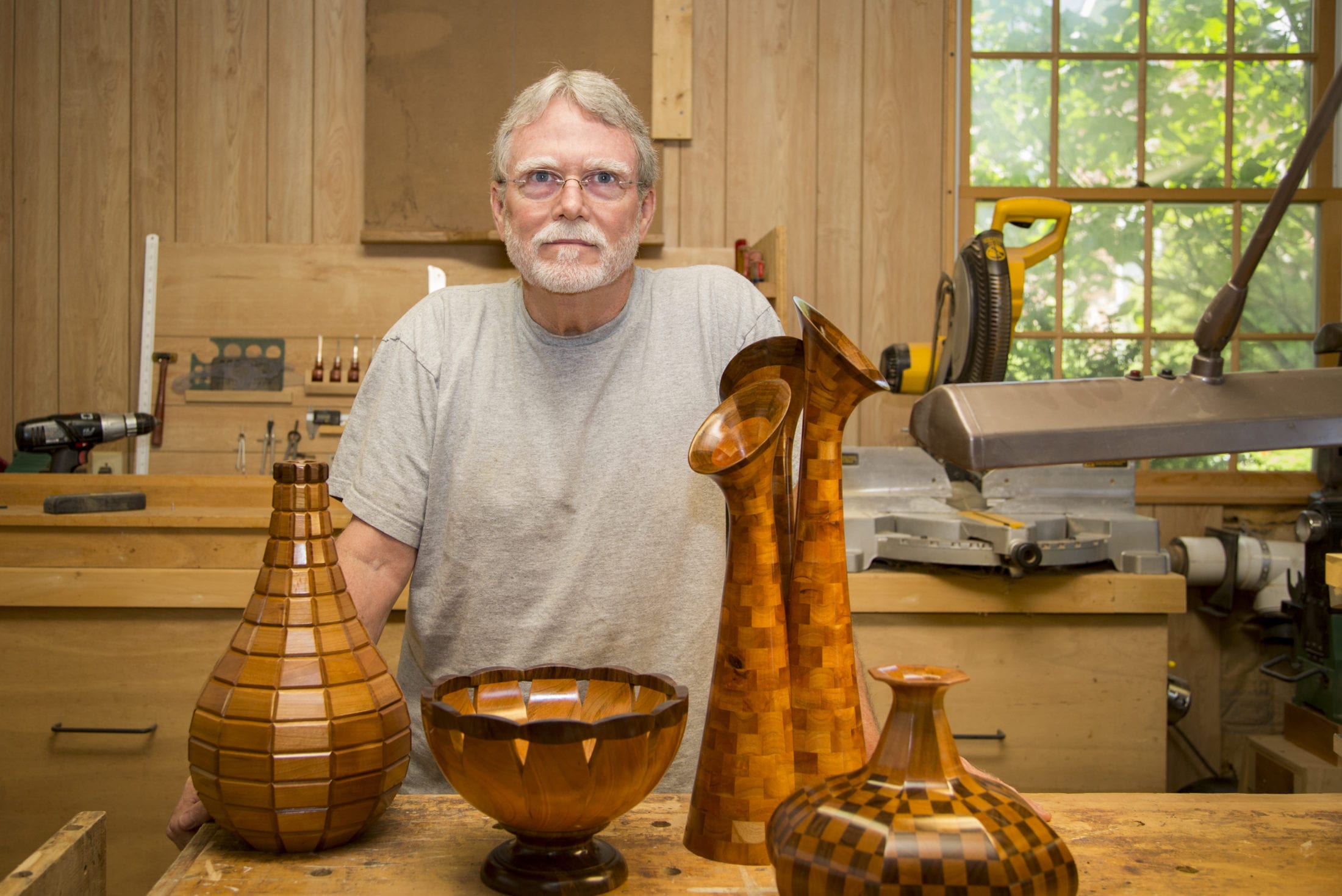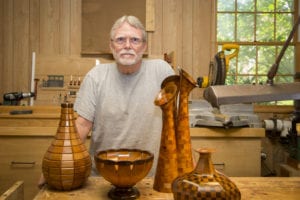Although shaped from cherry and black walnut, Richard Nolan’s sculptures flow like water into sinuous shapes.
They take the shape of vases, some tall and sporting elegant handles, some squat and featuring checkerboard patterns in two different types of wood. Others rise with the bells of trumpets or take a more angular shape, with spines projecting in every direction.
While their shapes echo the natural world, they are created by the hands of a SUNY Broome alumnus and retired engineer – not on a wood lathe, but meticulously assembled from hundreds of individual pieces that fit together exactly with a smoothness that resembles glass.
“My pieces have the impression of being functional. I try to make them as elegant as possible and it’s all handwork,” he said in his East Maine Road workshop.
He picked up a piece of one sculpture he’s working on which, when completed, will resemble an abstract circular vase with cut-outs revealing the interior. The vase-shape is comprised of nested pieces that he sands individually.
“It took four days to get to this point,” he said, holding up the piece of naked wood.
Broome roots
Nolan, who graduated from SUNY Broome in 1979 with a degree in Mechanical Engineering Technology, loved drawing as a child. In high school, he studied studio art for a year before a scheduling conflict prevented him from taking further courses.
His talent with a pencil found a new outlet in drafting, and he spent five summers as a draftsman for General Electric in Johnson City, a job that put him through college. He stayed on at SUNY Broome – then Broome Community College – for another year to complete his requirements for Engineering Science, before transferring to Clarkson University to complete his degree.
Click here to learn more about Mechanical Engineering Technology at SUNY Broome.
Click here to learn more about Engineering Science at SUNY Broome.
Nolan remembers SUNY Broome fondly, and participated in an alumni art show in the Library gallery in Spring 2018. He met his best friend at the college in 1977, and many of his friends date back to his college days. During his time at Broome, the chair of the Mechanical Engineering Technologies Program, Professor Herbert Durst, was a positive influence.
“He kept on me; I think he saw something in me. He gave me a lot of breaks I needed,” Nolan said.
Nolan’s own son earned an Engineering Science degree at SUNY Broome, and went on to become a civil engineer in the Washington, D.C., area. Quite a few family members and cousins also attended the school.
“I think it’s a great start for kids to get that two years and significantly reduced expenses,” he said, then paused. No, not all SUNY Broome students are just out of high school, then or now, he added.
“Even then, there was a mix of young and older students. It was a diverse student body back in 1977 to 1980,” he said. “I have a lot of good memories.”
After college, he spent 13 years at tech giant IBM, working on project development, before leaving in 1995 to become an engineering consultant. As an engineer, he worked in a variety of materials, from plastic pieces, casting and sheet metal to fiberoptics. After leaving IBM, he started his own business, expanding into the light manufacturing of fiberoptic components.
In 2007, his success allowed him to retire at the age of 50, and provided him the time and opportunity to develop his identity as an artist. After retirement, he needed a release for his prime motivator: the need to design, and see a vision through to manifestation. He found it two years later, when he challenged himself to design and build a wall sconce in a newly remodeled room in his home. Luckily, he had a supply of cherry and black walnut on hand and a few new woodworking techniques he hoped to try out.
The result: a piece of art that impressed even the self-described perfectionist. He has been designing and crafting his unique sculptures ever since, in the same woods – all meticulously planned out and drafted.
“I’ve come full circle. Everything became an artform for me,” he reflected.
Engineering art
It takes several weeks to make one of his intricate sculptures, not counting the time he needs to design it and sheen the wood to a reflective polish. There are multiple reasons for that. For one, sculptures can be composed of 500 to 600 separate pieces, which need to be flawlessly made and assembled. Each square in a checkerboard pattern, for example, is its own piece.
More important, however, is Nolan’s refusal to repeat patterns, which means there is no shortcut by using templates or even ideas from previous work. He has no common theme in his work, except the types of wood he uses, and no woodworking background to draw on; rather, he developed his technique on his own.
“Everything I do is a new piece; it’s a brand new design, something that’s going to test me,” he explained. “It’s very reflective of my background as a development engineer. Development engineers develop new ideas, new designs, new products. I’m always looking to do something I haven’t done before. I’ll envision a shape or a form, and make it work functionally.”
As an engineer, he can appreciate the difficulties of his chosen medium. Wood is asymmetric in the way it expands and contracts, and grain orientation matters in terms of both artistry and stability. But while Nolan’s sculptures may look fragile, they are actually more stable than if they were made out of a solid piece of wood.
“It’s problem-solving. It’s a difficult material to work with,” he said.
While many of sculptures appear seamless, they actually have quite a few seams – all of which have to line up perfectly. Many of the vessels, however smooth they appear, have multiple sides; his first piece was four-sided, and he has since created sculptures with eight, 12 and even 20 sides. All told, in the past eight years, he has completed more than 100 pieces, all unique.
While he first displayed his work locally at a show in Windsor, these days you can find Nolan at five to six art shows a year, including trips to Philadelphia, Baltimore and Washington, D.C. Most of his pieces have a price tag of between $1,000 and $2,000 – a steal when you consider how much work goes into each one.
Don’t ask him what is favorite is, though. Every piece is unique and important to him, and he feels compelled to give them names: Sunshine, Reflections, Harvest and Ravine, to name just a few.
“My last piece always ends up being my favorite piece,” he admitted.




